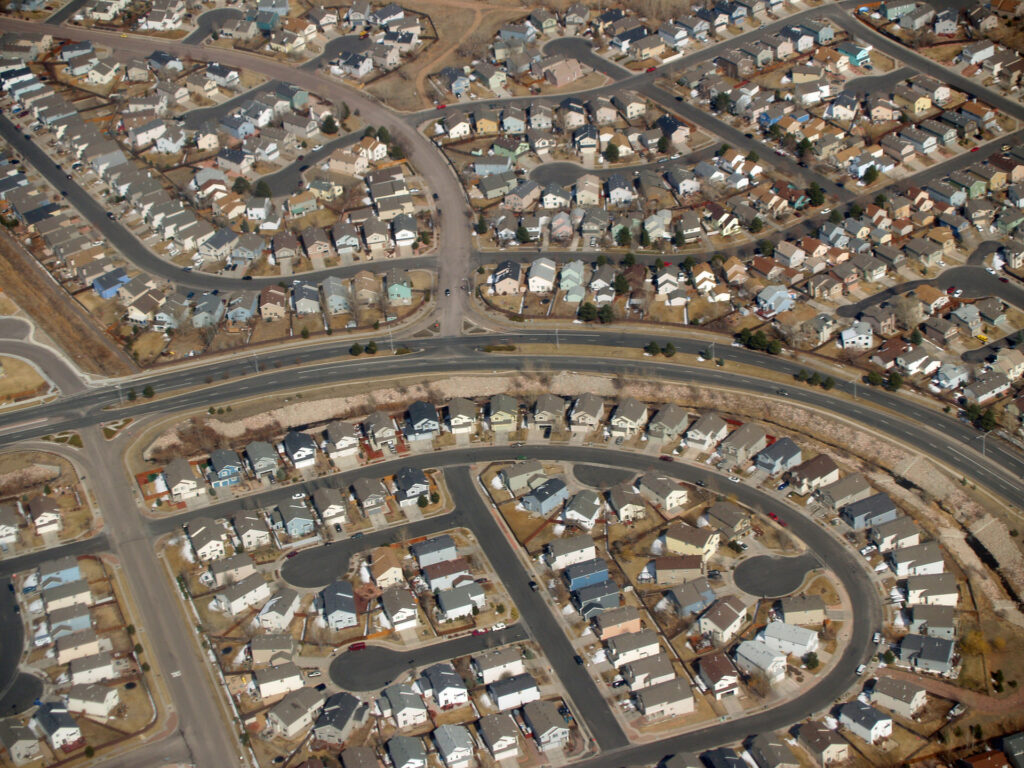Every major city in the U.S. follows the same pattern. At the core, there’s a large urban landscape comprised of mixed-use architecture and mid to high-rise buildings densely packed together. As you pan out from the center of the city you’ll find lower-density buildings with larger plots of land. This is common in cities around the world. What is unique to America is the suburbs. In the U.S. and its neighboring nations, mainly Canada, you’ll find a suburban sprawl. Suburbia has become almost synonymous with the American way of life over the last 70 years. But, is it the right way to build a city? As the years have gone by and we’ve watched this great suburban experiment unfold, it would appear that the suburbs are doomed to fail.
Ok, What Are the Suburbs?
Before we get too far into this let’s talk about the suburbs. What are they? Where did they come from? Aren’t the suburbs inevitable? We’re glad you asked.

Image courtesy of Wikipedia
The suburbs are an incredibly new way to build a city. People have been building cities for thousands of years. We’ve only been building suburbs for about 70 years. There are a few factors here. The largest being the invention of the automobile. Cars gave people the freedom and ability to travel much further distances in a single day than ever before. Prior to the widespread ownership of personal vehicles, cities had a limit to how much land area they could cover. The widest distance was about 10 miles from the city center. Anything larger than this was just not practical as people were unable to travel into the center of the city in a single day. In fact, most cities in history never came close to reaching this size.
The car was not the only thing that brought about the birth of the American suburb. In the post-war era, United States manufacturers were dealing with the end of the mass production of weapons, ammo, and other military supplies. These businessmen began looking for other ways to continue to mass produce products to increase profits. And so the American Dream was born. All of a sudden the American people were being mass marketed an ideal of white picket fences, single-family homes, land ownership, and so much more. Manufacturers began building homes, cars, and things to fill them both. It didn’t take long for suburbanization to spread like wildfire.
What is Wrong With the Suburbs Though?
Suburbia sounds great in theory, and even in practice, suburban life can offer a lifestyle unlike anything seen before in history. The problem with this lifestyle, however, is that of sustainability. The suburban model is a ticking time bomb.
Let’s look back at the historical model for cities. Generally speaking, most cities have followed the same lifecycle for thousands of years. Here’s that lifecycle in simple terms:
- Settlers find a nice place to call home.
- They build some shacks.
- When things are going well they tear down the shacks and build more permanent dwellings.
- Citizens start to work out of their homes.
- Successful ones convert part of their homes into a place of business.
- Very successful business owners build an addition on their home to live on either the second floor or a back wing of the business and work out of the original structure.
- The most successful build large structures for their place of business and include a place for them to live along with a place for a few friends to live and operate their businesses.
This cycle continues and continues throughout a long period of time until you have large multi-use buildings comprised of dozens of tenants. This growth pattern is natural and it allows cities to grow at a sustainable pace. It also provides higher tax value at a lower cost since a larger number of taxable entities exist in smaller land areas.
The suburbs cut this entire process out. This new model of city building took the principles of mass production learned during the world wars and applied them to home building and city planning. Where traditional city planning built when there was a need, suburban city planning built first then found a buyer with a need. In many cases, developers were able to find buyers. However, as time goes on it is becoming evident that a buyer is no guarantee.
Let’s Talk About Taxes
Taxes, we all hate them right? But, for cities to be successful it’s a necessary part of life. At the end of the day the more tax revenue that comes in the better. The suburbs have proven to be an inadequate model for generating enough tax revenue to meet all the financial needs of a city.
In traditional city development, most lots are multi-use lots with dozens if not more tenants. Not only are there many tenants but there are many different types of tenants. In one building there might be commercial space, office space, and residential space. Each of these spaces provides tax revenue in different ways and can help a city grow. Suburbs, on the other hand, are typically larger lots and are comprised of a single tenant. Needless to say, the tax revenue from this type of space is significantly lower.
It gets worse though. Not only do these lots bring in less revenue, but they cost more. Since suburban lots are generally larger utilities and infrastructure needs to cover more ground to accommodate the same population as a more urban city environment. Larger bills and lower-income is a recipe for insolvency and that is the road most American suburbs find themselves on today.
The End of the Suburbs
Most of the infrastructure and utilities built over the last hundred years have a similar life span of about 30 years. The suburban model is successful only while replacements are not necessary. The income level can usually cover the cost of maintenance, but it is not nearly enough for replacements.
So many cities have rings of “decay” wrapping around the city center. The original suburban towns built in the 50’s/60’s have already reached the point of insolvency and have largely been unable to make it out of the hole they fell into. In these areas roads are in disrepair, utilities are strained, public services departments are underfunded, and the neighborhoods become habited only by lower-income individuals. The second ring of suburbs built in the 70’s/80’s has just recently reached the point of insolvency. These towns are beginning to need full replacements of infrastructure and utilities. Funding has yet to completely dry up so some services are still hanging on. These suburban towns are typically home to lower middle class or middle-class individuals.
The third ring built in the 90’s/2000’s is nearing the point of insolvency. But, for many of them, they have not yet reached this point. Now we are continuing this experiment and watching this cycle play out once again with a new ring of suburbs. A new ring that is likely to meet the same fate as those before them.
What Can Be Done?
There’s a long list of things to be done to save the urban landscape in America. The most important, and the most difficult, thing on the list is transitioning back to the traditional city planning strategies. Lots would need to be transitioned to multi-use, multi-tenant buildings on smaller lots.
The list goes on and many of these strategies are discussed in this episode of Things I Learned Last Night. Watch or Listen using the media players above. Things I Learned Last Night is an educational comedy Podcast staring best friends Jaron Myers and Tim Stone. If you love learning new things and laughing while you do it then you’ll love TILLN. Also, be sure to check out Strong Towns by Charles R. Marohn Jr. We used this book as a cornerstone in studying for this episode. You’ll learn so much about the suburban city model’s shortcomings and the ways to improve upon it.
Related Episodes
Sources
Strong Towns by Charles R. Marohn Jr.
The Growth Ponzi Scheme – Strong Towns
Tell Us What You Think of This Content!
Don’t forget to share this episode with your friends!

